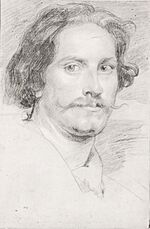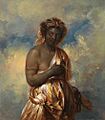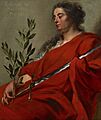Jan Boeckhorst facts for kids
Quick facts for kids
Jan Boeckhorst
|
|
|---|---|

Portrait of Jan Boeckhorst by Abraham van Diepenbeeck after van Dyck
|
|
| Born |
Johann Bockhorst
circa 1604 |
| Died | 21 April 1668 (aged 64) |
| Nationality | German |
| Known for | Painting |
| Movement | Baroque |
Jan Boeckhorst (born around 1604 in Münster, Germany – died April 21, 1668, in Antwerp, Belgium) was a talented painter and artist. He was born in Germany but spent most of his life working in Antwerp, which was then part of Flanders.
Boeckhorst was a very flexible artist. He painted many different types of art, including:
- History paintings: These show important moments from history, myths, or religious stories.
- Genre scenes: These show everyday life.
- Portraits: These are paintings of people.
His style was inspired by famous painters from Antwerp like Peter Paul Rubens, Anthony van Dyck, and Jacob Jordaens. Boeckhorst also designed pictures for tapestries, which are woven wall hangings.
Contents
Life Story
Jan Boeckhorst was born in Münster, Germany. He was the second oldest of twelve children. His family was well-known and respected in Münster. His father, Heinrich, even served as the mayor for a time.
When Jan was 17, he became a canon in the Jesuit order. This means he joined a religious group. He didn't start studying art until he was about 22 years old.
Moving to Antwerp
Around the mid-1620s, Boeckhorst moved to Antwerp. He likely went there to learn from the famous painter Peter Paul Rubens. We don't have strong proof that he was officially Rubens' student, but they worked closely together in the 1630s. Boeckhorst might also have briefly trained with Jacob Jordaens when Rubens was away in London.
In Antwerp, people called Boeckhorst Lange Jan, which means Tall John. This was because he was very tall!
Early Work and Collaborations
From 1626 to 1635, Boeckhorst worked on a big project. A rich merchant named Lodewijk De Roomer paid him to create 26 paintings for a chapel in Antwerp. These paintings, which he made with another artist named Jan Wildens, are now lost.
Between 1627 and 1632, Boeckhorst probably worked closely with Anthony van Dyck. Van Dyck had returned to Antwerp after living abroad for a long time. The two artists created some artworks together. Boeckhorst also made copies of van Dyck's paintings.
Becoming a Master
Boeckhorst became a master in the Antwerp Guild of Saint Luke in 1633–1634. This meant he was a recognized professional artist. He often worked with Rubens' workshop in the mid-1630s.
One important project was decorating Antwerp for the "Joyous Entry" in 1635. This was a big celebration for the new governor of the Netherlands, Cardinal-Infante Ferdinand. Rubens was in charge of this whole project. Boeckhorst helped by painting parts of the 'Arch of Isabella' and figures like 'Securitas' and 'Salus publica'. He worked with Gerard Seghers and Jan Borchgraef on this.
Travels to Italy
In 1635, Boeckhorst traveled to Italy. He returned to Antwerp and worked on another large project from 1636 to 1638. This was for the Spanish king Philip IV. He helped Rubens' workshop create mythological decorations for the king's hunting lodge, the Torre de la Parada, near Madrid. Boeckhorst painted these decorations based on Rubens' oil sketches.
In 1639, Boeckhorst traveled to Italy again, staying in Rome. There, he likely joined a group of Dutch and Flemish artists called the Bentvueghels. This group had a tradition of giving each member a nickname. Boeckhorst's nickname might have been Doctor Faustus.
We don't know exactly when he came back to Antwerp, but it was sometime between 1639 and 1649. After Rubens died in 1640, Boeckhorst finished some of Rubens' unfinished artworks. When he returned to Antwerp, he received many requests for paintings from churches in Flanders.
Later Life and Death
Jan Boeckhorst passed away on April 21, 1668, in Antwerp. He was buried in the Saint James Church. After his death, his large collection of art was sold. The sale lasted six days and brought in a lot of money. His collection even included many early drawings by Rubens.
His Artworks
General Style
Boeckhorst was a very flexible painter. He created:
- Paintings about religious and mythological stories.
- Allegorical works (paintings that use symbols to represent ideas).
- Scenes of everyday life.
- Portraits of people.
He also designed pictures for tapestries. He is known for designing eight tapestries based on the myths of Apollo. Eight of his early drawings for this Apollo series are kept in a museum in Bergues, France.
Boeckhorst also made designs for publishers in Antwerp. In the early 1650s, he designed pictures for religious books. These designs were then engraved by Cornelis Galle the Younger and published by the Plantin Press in Antwerp.
Only three of Boeckhorst's paintings are signed and dated (between 1646 and about 1660). Five others are dated only from 1659–1666. His first signed painting, Madonna and Child with Saint John, is from 1646. Because so few paintings are signed, it can be hard for art experts to be sure which works are truly by Boeckhorst.
Working with Others
It was common for artists in Antwerp to work together. Boeckhorst often painted the people in artworks, while other artists painted the backgrounds or other parts. He collaborated with:
- Jan Wildens and Jan Brueghel the Younger for landscapes.
- Frans Snyders for still life elements (like food or objects).
For example, in the painting Peasants going to the market (in Rubenshuis, Antwerp), Boeckhorst worked with Frans Snyders. This large painting shows everyday life and also represents the four elements (earth, air, fire, water). It shows how Jordaens' genre paintings influenced Boeckhorst.
Boeckhorst might have also worked on "garland paintings." These were a special type of still life painting that started in Antwerp. They usually showed a wreath of flowers or fruits around a central image, often religious. These paintings usually involved two artists: one for the flowers and one for the figures. We don't have any definite garland paintings that Boeckhorst worked on.
Boeckhorst is also thought to have made changes to some of Rubens' paintings. For example, he changed a portrait by Rubens called King David playing the Harp around 1640/41. He also might have made Rubens' Rise of the Blessed larger. After the late 1630s, Boeckhorst seemed to stop working with other artists as much.
Portraits
Boeckhorst's portraits were influenced by Anthony van Dyck and Cornelis de Vos. These two were the top portrait painters in the early 1600s. Boeckhorst sometimes painted lively group portraits.
In his group portraits, he often showed the importance of strong family bonds. This was called Concordia familiae. Boeckhorst was good at making his subjects look natural and full of life. His portraits felt informal and real. He also used drapes in the background, which he painted very vividly, similar to Jordaens.
Later Works
His later works, from the 1650s and 1660s, include many altarpieces for churches across Flanders. Altarpieces are artworks placed behind the altar in a church. He also continued to design pictures for tapestries.
In these later works, you can still see the strong feelings and colors of van Dyck's figures. An example is Ulysses discovers Achilles dressed up as a girl.
Images for kids







